Lenovo P70 Review: Eight-core processor, 4,000 mAh battery and five days of battery life
In the second half of 2013, Lenovo began selling the P780 smartphone, belonging to the “professional” P line. This device very successfully combines several qualities that are unusual for middle-class models. Firstly, this is a metal case: the developers of “smart phones” on Android do not often indulge us with this material today, and then, in 2013, it was completely met in a few number of models. Secondly, the Lenovo P780 used a bundle of a powerful 4,000 mAh battery and an economical MediaTek MT6589 chipset with a quad-core 28-nanometer processor. To understand: at that time, batteries with a capacity of 1,500–2,000 mAh were considered the norm for smartphones, and the majority of low-cost chipsets were manufactured using much more “voracious” 45-nanometer technology. As a result, the battery life of an average smartphone did not exceed one day. But Lenovo P780 easily lived without a power outlet for more than two days - and this is in a very intensive mode of operation. Rejecting the constant attacks in the social network and reducing the screen brightness to 15-20%, it was possible to extend the device for four days without any problems.
In other words, the Lenovo P780 became a kind of mini-revolution for 2013. However, for the beginning of 2015, its characteristics are no longer relevant. What is Lenovo doing? That's right, represents the heir to the P780 - the Lenovo P70 model. It also belongs to the P series and is also equipped with a 4,000 mAh battery. As for hardware, the Chinese manufacturer called MediaTek to the rescue: the Lenovo P70 uses the latest MT6752 chipset with eight processing cores. It is based on the 64-bit architecture of the new generation ARM Cortex-A53, which, together with a number of new technologies from MediaTek, makes the P70 a smartphone with a really powerful and high-tech “stuffing”.
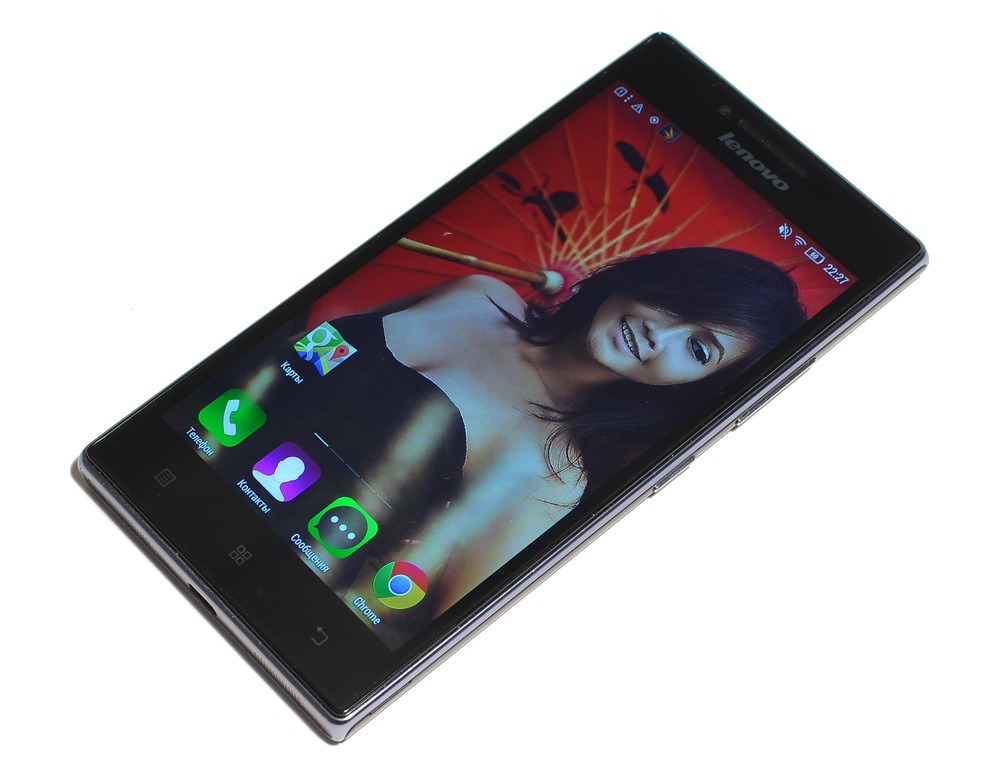
The box showed instructions, warranty card, charger unit, USB-microUSB cable, simple wired headset, bumper case and OTG cable. The latter is also a feature of Lenovo's “professional” smartphones - they say that an advanced user may need to connect a mouse, a keyboard, and a USB drive to his device. Yes, the accessory is cheap, but it's nice that you won't have to run to the store for it. By the way, the OTG cable was also bundled with the P780.
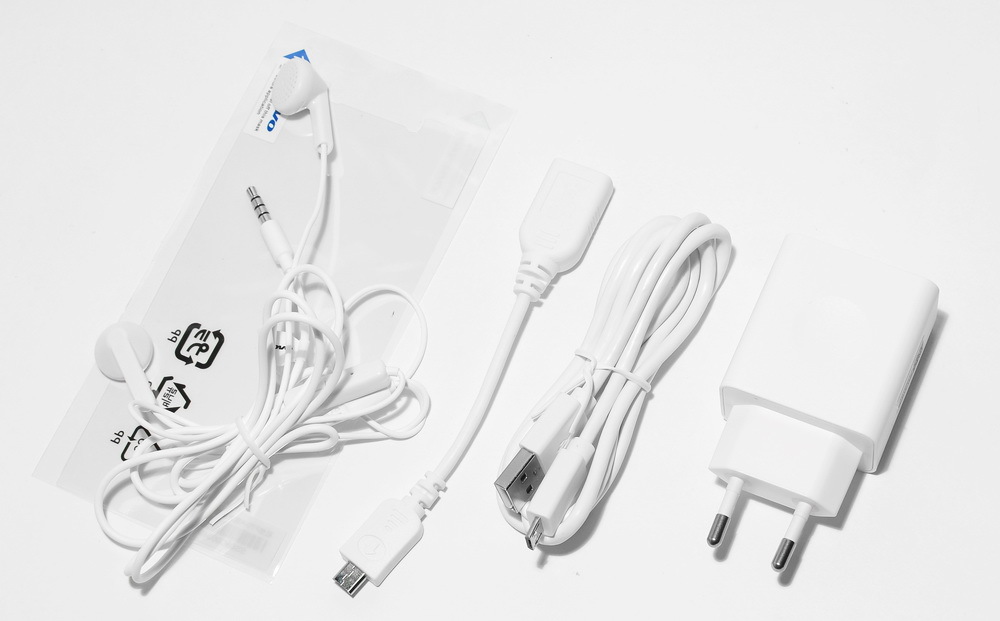
')
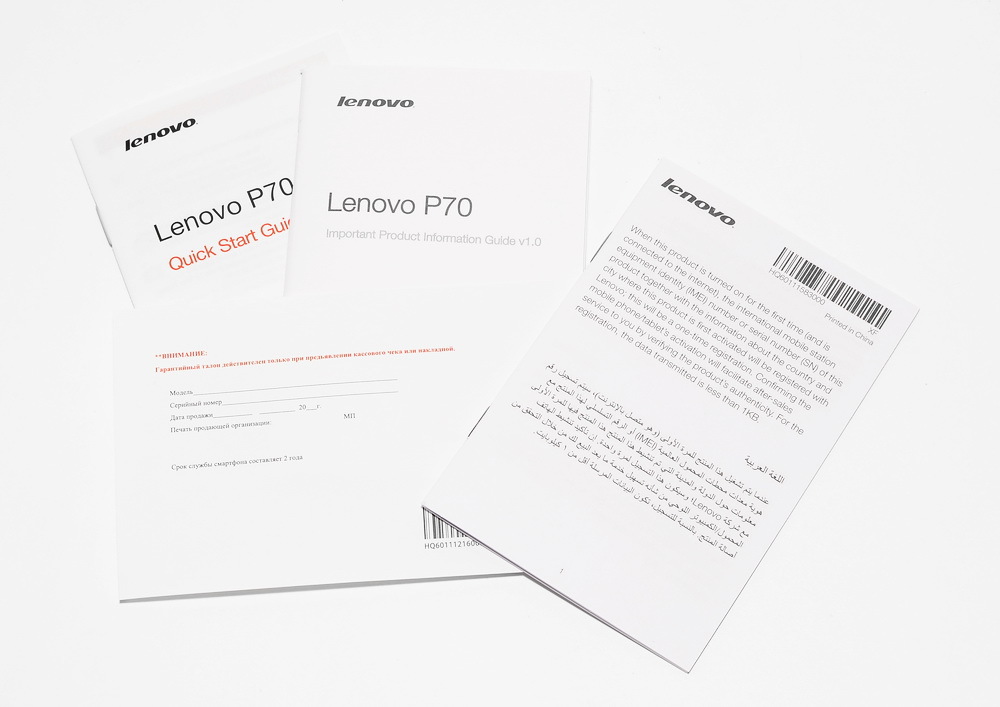
The bumper is made of solid black plastic. The surface of this accessory is rough, so it is quite difficult to drop the Lenovo P70 from the hand, the “pad” clings well to the palm. Moreover, the bumper sits on the device very tightly, and an unprepared user can even decide that this is not a removable part, but a tightly screwed part of the case. In general, Lenovo can be thankful for the described accessory: covers of this type cost at least one and a half thousand rubles and, as a rule, do not differ in quality. And here he gets free and made quite neatly.
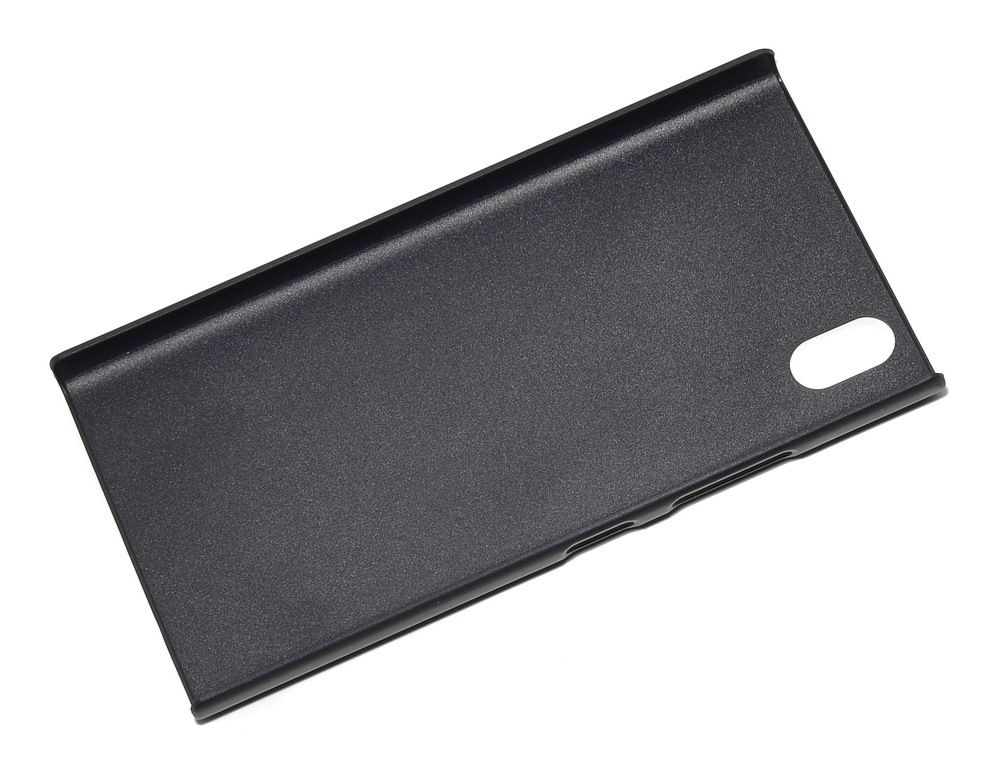
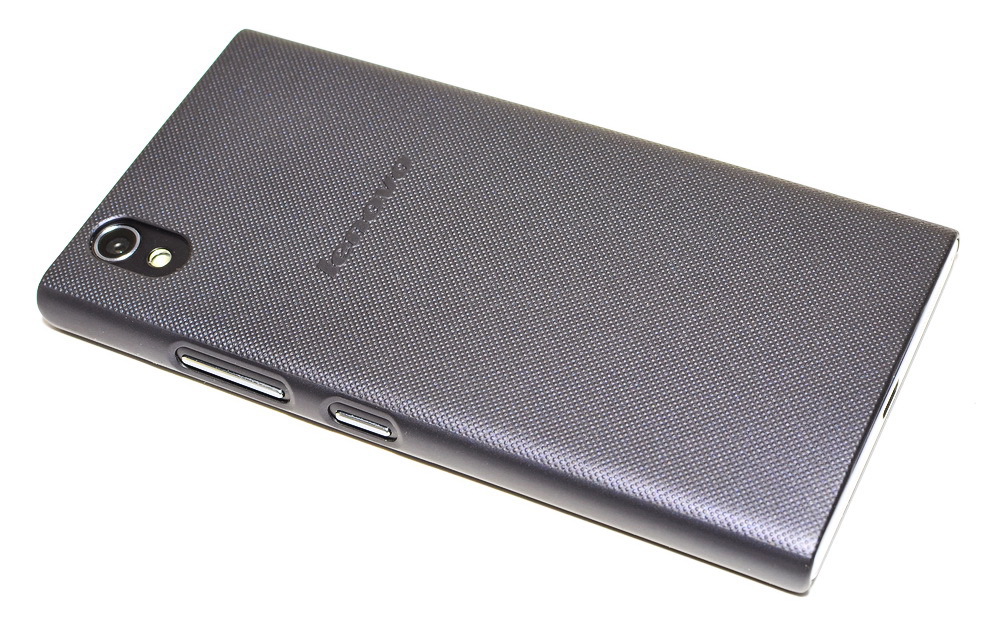
It would seem that 8.9 mm in thickness is, by modern standards, too “thick”, however, surprisingly, the Lenovo P70 is perceived as a rather elegant thing. And the device is quite light: with a weight of 149 g, it can be called one of the lightest 5-inch smartphones. Whether this is good or not is an open question: sometimes it seems that the balance of dimensions and weight in the P70 is a little broken. In other words, the hand of this device is not pleasantly not - and we would not mind if he weighed a little more.
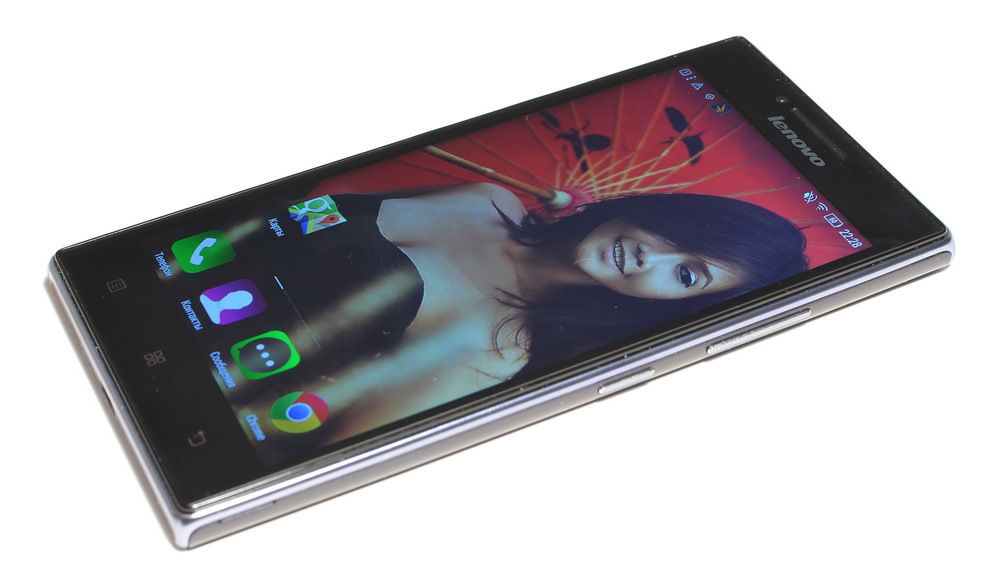
Build quality is excellent - nothing to complain about. The case girthly surrounds a frame of the color “dark silver with a pearl shimmer”. Unfortunately, it is not metal at all, but plastic. Moreover, unlike the P780, the Lenovo P70 is entirely made of plastic. Alas, oh: no trace of the metal.
The back panel of the smartphone is smooth matte, and it is believed that over time, it can noticeably wipe. Perhaps, the same opinion is held in Lenovo, and that is why they put a bumper that is much more resistant to external influences in a box with a smartphone. The back of the P70 bears only three elements: a 13 megapixel camera lens, a flash eye and a silver company logo.
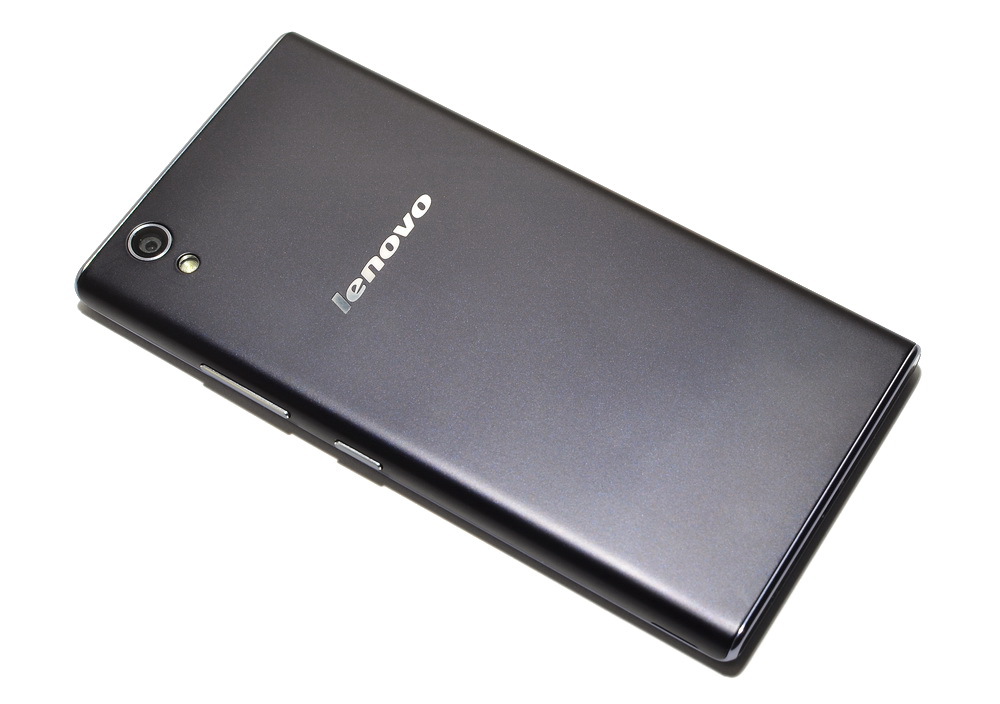
The lower and upper ends of the smartphone are glossy, here there is an attempt to "make up" the plastic is no longer under the metal, but under the glass. The attempt is quite successful, only fingerprints collect this surface very quickly. On the upper side of the case there is a standard 3.5 mm headphone jack and a microphone, on the bottom there is another microphone, a pair of rather loud speakers and a microUSB port. As you can see, there are two microphones in the Lenovo P70: the device has a noise cut-off system during a conversation. And indeed, the quality of voice transmission is excellent.
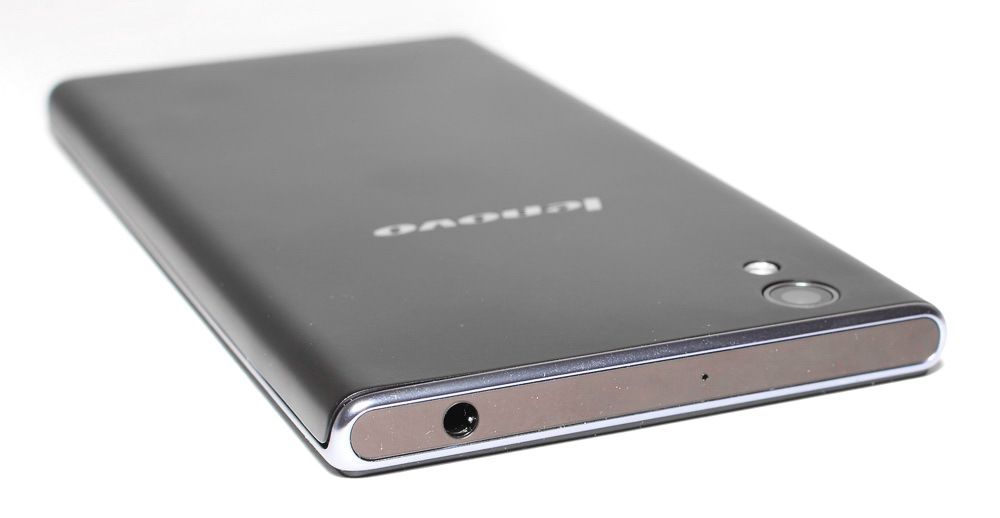
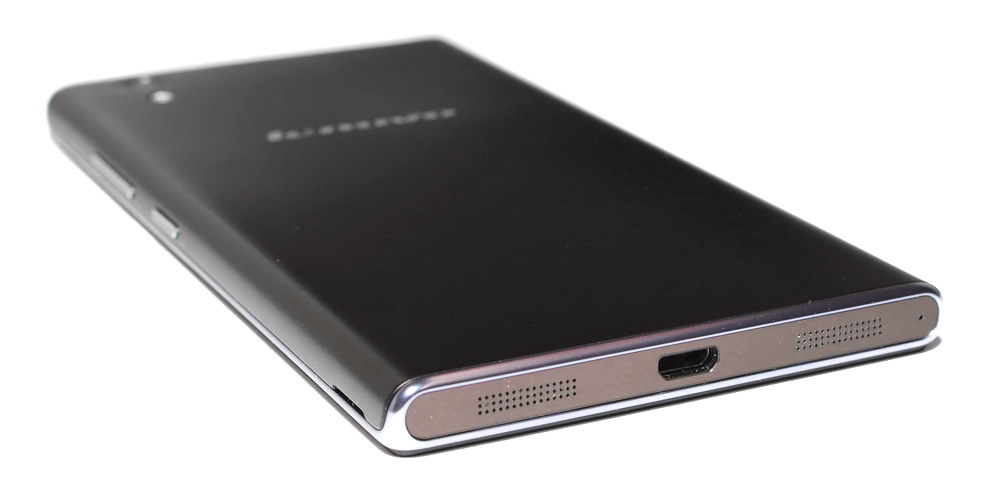
On the right side of the case - silver buttons to adjust the volume and turn on the device / screen. There are no questions for them: they are pleasant to the touch, a clear move. By the way, the keys are not embedded in the smartphone itself, but in its removable back panel.

The front panel has a half-millimeter rim, and developers can only be commended for this solution: if you put the Lenovo P70 screen down on a flat surface, the protective glass will not touch it. By the way, about this very protective glass: unfortunately, Lenovo does not tell who its manufacturer is - Corning or, for example, Asahi Glass. But the fact is that for a couple of weeks of intensive use there were no scratches and scuffs on it. Fingerprints and other dirt on it also practically do not accumulate: for this it is worth saying thanks to the quality oleophobic coating.
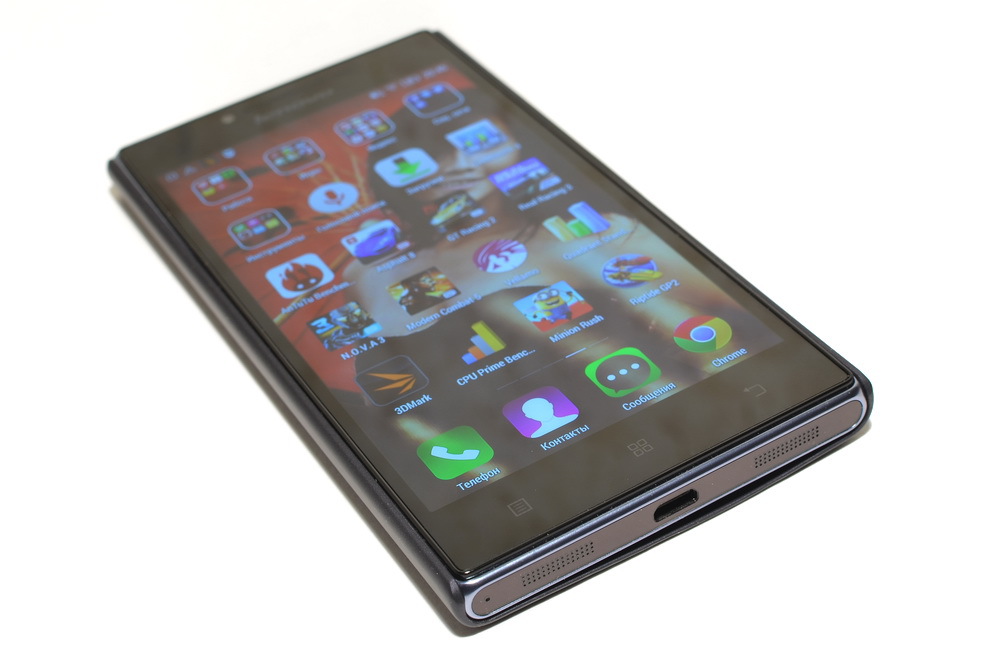
Above the screen is a standard set of components: light and proximity sensors, a speaker with built-in LED-indicator and a front-facing camera.
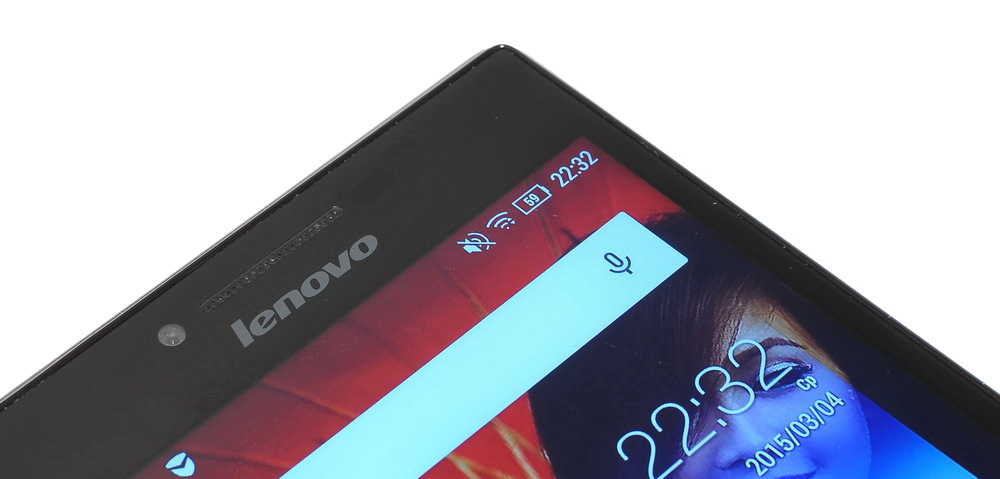
Below the display, there are three Android touch control buttons with icons made in the Lenovo style. All is good, but they have a very dim backlight. We thought that its brightness can be raised in tinctures, but, unfortunately, we did not find such an option.

Remove the back cover by hooking it with a fingernail for a special notch on the right side. Immediately struck by the inscription warning against removing the battery: it is not removable. Although, to be honest, I just want to remove it - there are no visible attachments to the battery. Even under the back cover there is a slot for microSD cards and two slots for SIM-cards of the microSIM format. The left provides support for 2G, 3G and 4G networks, the right - only 2G. A bit strange solution: in many “dual-purpose” smartphones on MediaTek chipsets, both slots are “equal” and can support any network - from GSM to LTE.
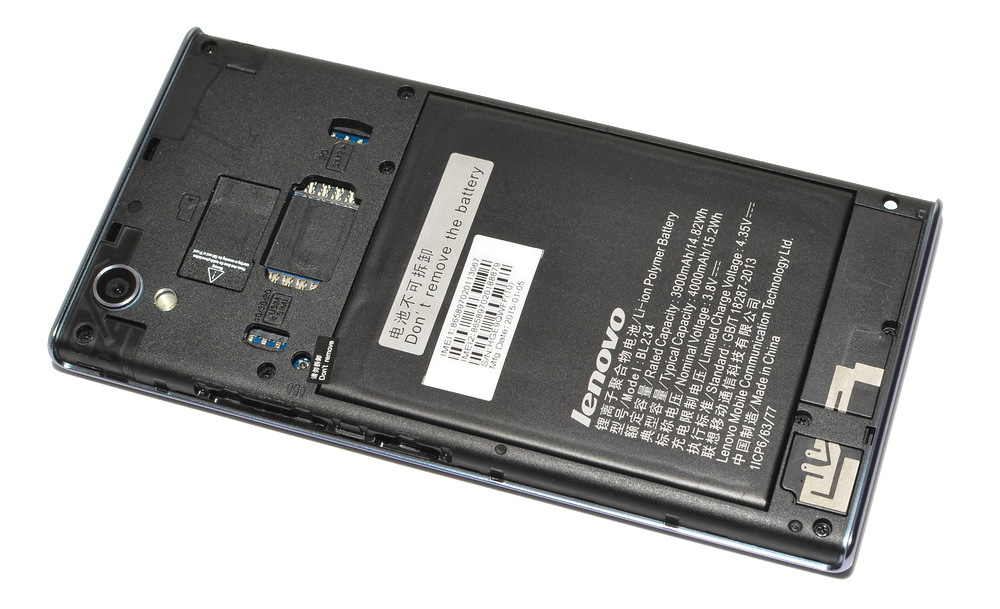
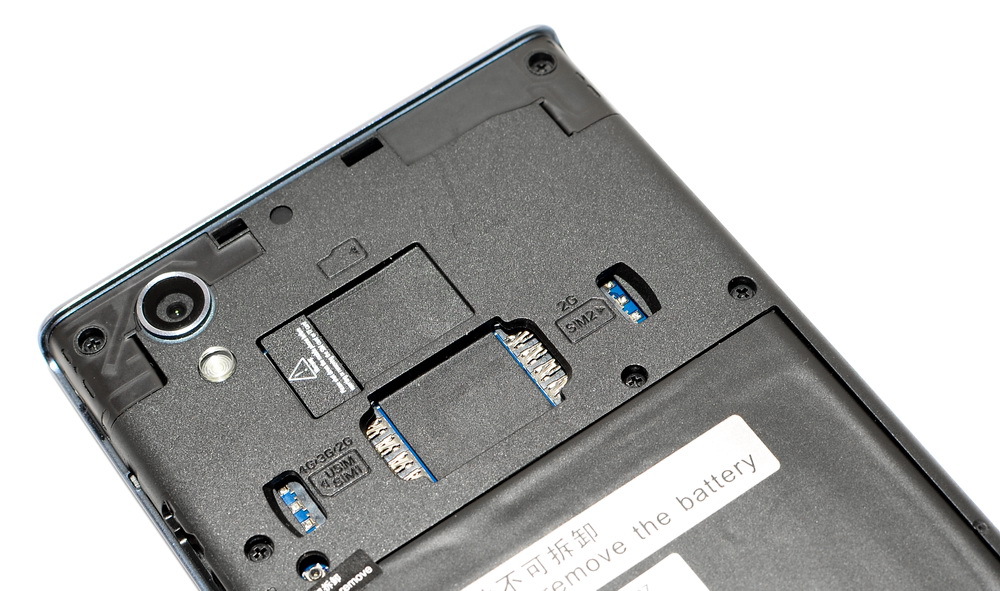
Before going directly to the screen, it is worth noting that the MT6752 chipset implements a number of proprietary technologies from MediaTek, designed to improve the quality of the image on the screen. So, ClearMotion technology increases the frame rate in video from 24-30 per second to 60 in real time. Do I need to explain that this significantly improves the smoothness of the display image. Meanwhile, the technology MiraVision adjusts saturation, brightness and contrast when displaying various multimedia content, achieving the most beautiful pictures and simultaneously saving battery power. All this is achieved by adjusting the intensity of the display backlight depending on the brightness of the ambient space (whether it is a room or a street) and the color gamut of the content displayed on the screen. Usually in the settings of smartphones there are special items dedicated to ClearMotion and MiraVision, but for some reason we did not find them in the Lenovo P70. However, as far as we know, smartphone developers may not give access to the MiraVision tweaking: they simply activate this option by default, and it works seamlessly for the user.
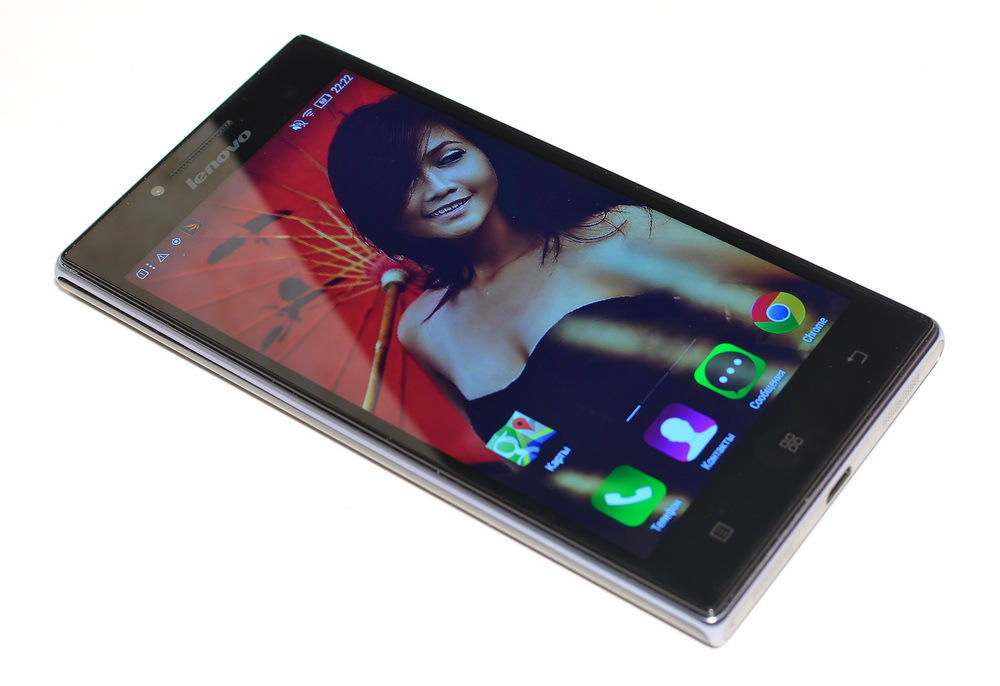
In general, the display of the Lenovo P70 is quite good. Its diagonal is 5 inches with a resolution of 1280 x 720 pixels (HD720p). The matrix is made using the IPS technology, plus the One Glass Solution (OGS) technology is used, ensuring the absence of an air gap between the LCD panel and the sensor layer. As a result, the brightness and image quality increase, as if it was cut from a glossy magazine and lies on the front panel of the smartphone. Wide viewing angles: up to 178 degrees both vertically and horizontally. The color rendition is natural and pleasant to the eye.
The touch screen layer is made by capacitive technology, supported by up to five simultaneous keystrokes. Sensitivity is very high.

This is where the fun begins. MediaTek MT6752 can be called the “successor” of the MT6592 chipset, which at one time became the first full-fledged “eight core” for smartphones in the world (that is, with the possibility of simultaneous operation of all eight cores - this chip was preserved in M6752). What has changed in MT6752 compared to its predecessor? Yes, almost everything except the principle of operation: the new chipset also has eight cores of the same type - ARM Cortex-A53 (instead of Cortex-A7 for MT6592), that is, the big.LITTLE architecture does not apply.
Thanks to the steady growth of the share of Lollipop - the latest version of the Android OS - the term "64 bits" is being transformed from a technical term into a real market advantage. MediaTek became the first chip maker to offer a full line of 64-bit solutions - from chipsets for low-end smartphones to chipsets for flagship devices.
What is the value of 64-bit solutions? Firstly, the 64-bit ARMv8 architecture (used in the MT6752) itself is much simpler, energy efficient, and faster compared to the 32-bit ARMv7 architecture. This means that the smartphone interface will work smoother, applications will be more responsive, and the game of demanding 3D-games and 4K-video playback will almost cease to be accompanied by departures to the desktop.
Secondly, as mentioned above, the new OS from Google is optimized to work with 64-bit processors. In Android 5.0, a new environment (virtual machine) is used, in which Android applications run, so that their launch and switching from one application to another is faster, and the system again becomes more energy efficient.
And one more thing: 64-bit processors are capable of supporting four or more gigabytes of RAM by a smartphone (in theory this is achievable in the case of 32-bit processors, but then the developers of the device will have to noticeably more incendiary dance with a tambourine) year will only increase.
One way or another, it’s certainly not necessary to complain about the speed of work in the case of the Lenovo P70. Despite the rather heavy in terms of graphics shell for Android called Vibe UI, there are no delays when switching between screens, menus and submenus, applications and games start almost instantly, the camera turns on in just a second. All this suggests that MediaTek MT6752 in conjunction with 2 GB of RAM can provide a very high speed device. And not only in basic applications, but also in games. Here comes to the aid of the graphics accelerator Mali-T760MP2 with a frequency of up to 700 MHz. This is one of the most powerful solutions, not only by the standards of middle-class smartphones, but also by the standards of flagships.
Let's admire what the Lenovo P70 with its MT6752 demonstrates in benchmarks.






Needless to say that almost all modern games run and work on the Lenovo P70 without any brakes or jams? Here, for example, the notorious Asphalt 8 races. The graphics settings provided for in this game can be set to the maximum level.


But World of Tanks: Blitz. The picture is updated at a frequency of 57 fps, although 30. is enough for a comfortable game. This means that the MT6752 provides a substantial "margin of safety". For comparison: the Samsung Galaxy S5 for 30 thousand rubles gives out in this game no more than 50 fps.

Continuing the story about the features of the MT6752, it is worth mentioning the MediaPek CorePilot technology. It is responsible for intelligent control of the operation of the cores and allows not only to select the number of operating cores in accordance with the current load, but also to change their clock frequency in real time. After all, not every game or any other “heavy” application requires the work of all cores to the fullest. When it is possible to reduce the frequency or disable an unnecessary core in a given millisecond, CorePilot does just that. The result is a saving of up to 20% of energy (and, therefore, battery life) compared to a similar chipset without CorePilot technology.
The screenshots below from the CPU-Z application illustrate well the work of the CorePilot technology. On the first image, the smartphone is in standby mode, and only one core is operating at the minimum frequency - 468 MHz. In the second case, the browser is running, and two cores are activated. In the third case, the loading of the game began, in connection with which six computing cores were launched at once.



Now - about the wireless modules. MT6752 is a highly integrated solution that includes Wi-Fi 802.11 b / g / n adapters (with support for Miracast and Wi-Fi Direct), Bluetooth 4.0 LE, GLONASS / GPS, and a modem with support for two SIM-cards and a fourth connection LTE standard generation (Cat. 4, up to 150 Mbps). Note the following fact: there was no LTE modem in the MT6592, but one or another smartphone on this chipset could support 4G using a separate chip, MT6290. But in MT6752, as mentioned above, the modem is integrated initially, which provides energy savings of 7-10% compared with the “external” solution. It's nice that MediaTek chipsets are becoming more and more advanced technically with each generation.
From the pleasant we note the non-standard implementation of Miracast in the version from MediaTek: not only the usual duplication of the image from the smartphone’s display onto the TV screen is supported, but also the ability to transfer an image from another application to the external screen. For example, on the screen of the Lenovo P70, a browser or any game can be opened, and this will not interfere with the transmission of the episode of the series to the TV “in the background.
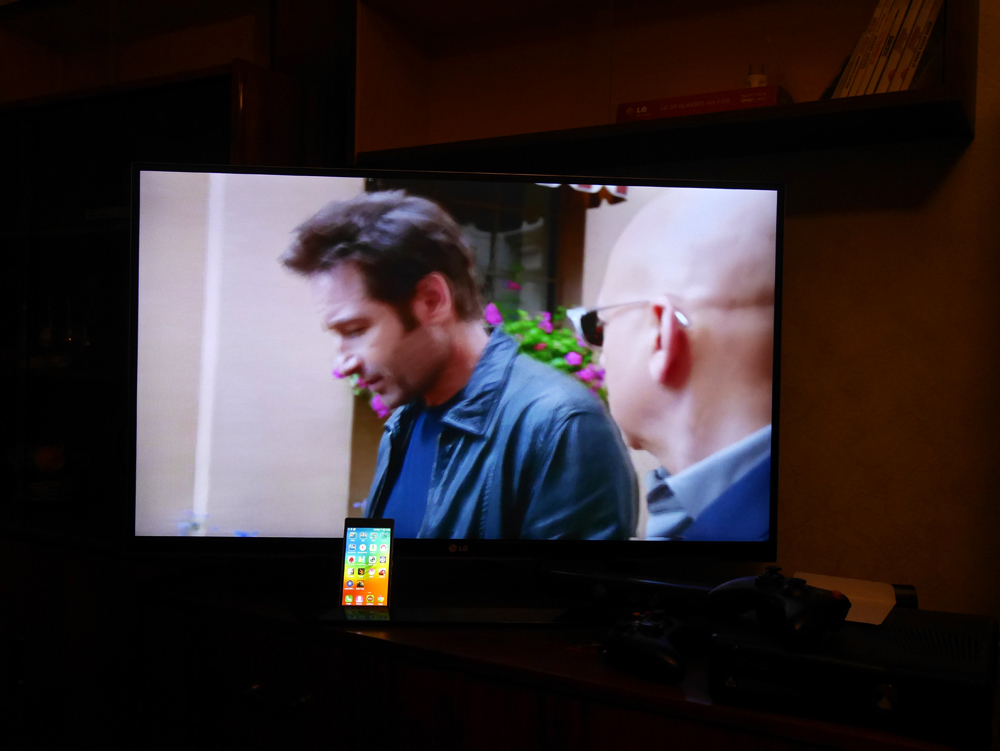
We also add that the Lenovo P70 has no problems with navigation: the satellites are in a matter of seconds, and both with and without A-GPS support.

On memory in short: the P70 provides a storage capacity of 16 GB, plus there is the possibility of installing a flash card microSD up to 32 GB. At least that's what Lenovo claims. However, in our case, the device without any problems recognized the 64 GB card.
The front camera of the Lenovo P70 is 5 megapixel with fixed focus. Its capabilities are quite enough for video telephony, and for creating self-portraits. Moreover, MediaTek didn’t manage to do this either: the device uses Face Beautifier technology, which acts as an instant “photoshop”: it optimizes tone and removes minor defects on the face. Use the slider to set the intensity of the option. Here are some examples of how Face Beautifier works.
From left to right: no improvement, wrinkle removal, facial brightening.



As for the main camera, it is equipped with a 13-megapixel matrix and an autofocus lens. There is also an LED flash, which, by the way, can be used as a flashlight. The quality of images can be estimated from the examples below. From myself, we note that this is not the best 13-megapixel camera in the world, but not bad. She is well given macro photography, and she copes with landscapes without any problems. Well, the stumbling block for the Lenovo P70, as for most smartphones, is shooting in poor light conditions: the quality is noticeably reduced. Photos are clickable:





And this is what the camera interface and settings look like. Video smartphone writes in maximum resolution Full HD 1080p.






Lenovo P70 is running Android 4.4.4 KitKat. Whether the upgrade to version 5.0 of Lollipop will be is an open question: it already depends on Lenovo. By the way, during testing on the P70, a minor update flew through the air - 10 MB.



Let's say frankly: on the Vibe UI interface of Lenovo smartphones - more precisely, according to its differences from the standard Android interface - you can write a dissertation. There are so many different chips in Vibe UI that it is very, very difficult to list them, without forgetting about any trifles.
Let's start with the fact that on the lock screen, you can scroll through the wallpaper. It is difficult to say why this is necessary in practice, and yet this moment somewhat diversifies the experience of operating a smartphone.


You can activate the screen by double tapping on it. Well, in general, all sorts of settings related to gestures and taps, the car and a small truck.

There is no main menu in the usual sense: application icons are located on desktops and can be grouped into folders. In this, the Vibe UI resembles iOS.



This is what the notification bar looks like. It includes, among other things, a slider for adjusting the screen brightness, which is absent in the “bare” Android 4.4 KitKat . And also the notification panel has a lot of settings.


Implemented support for interface themes. True, there are only two of them, and the ability to download new regular means, apparently, is not provided. You can also choose a launcher, however, only one option is offered - Lenovo Launcher (that is, Vibe UI). If memory serves us, in some Lenovo smartphones, at this settings point, you can switch to the “bare” Android.

From the unusual - the ability to display a virtual key that hangs on top of all applications and interface elements. It opens access to a set of the most important options.



Another Lenovo added to the interface option to create screenshots of individual screen fragments. And redrawn the manager of running applications.


Particular attention is paid to energy consumption. The device has options designed to limit the performance of the device, as well as a special emergency mode, which disables most functions. You can only make calls, use the alarm clock and read / write messages.


Concluding the talk about software, we note that the pre-installed applications are full — from the Lenovo suite, which includes antivirus, among other things, to the clients of social networks and Yandex services. It makes no sense to describe this entire collection, just know that by purchasing a Lenovo P70, you are unlikely to go on Google Play in search of software - the developers have foreseen everything you can and cannot do.
From one battery charge, the Lenovo P70 is stable for two and a half days - and this is with regular walks on social networks, connecting to an LTE network and an hour of games per day. If the first and third points are excluded, then the device will most likely last four days. In fact, despite the increased performance in three times, the Lenovo P70 is not inferior in terms of autonomy of the P780 model with the same battery. All this suggests that the key to long battery life is not only in a powerful battery (although it is certainly very important), but also in a set of energy-saving technologies - like the CorePilot from MediaTek. Thanks to them, problems with autonomy can be avoided even in the case of Android OS devices, which are still famous for their “gluttony”.
The Lenovo P70 is truly a worthy heir to the P780. Having preserved the philosophy of its predecessor, the device noticeably “grew” under the article “productivity”. He has a powerful MediaTek chipset with an eight-core 64-bit processor, suitable for all modern toys, a good camera, an LTE modem, support for two SIM-cards - in short, everything you can require from the device for such money. The only serious drawback of the novelty is the absence of the metal case that has glorified the P780, and with it the pleasant tactile sensations from the device and the feeling of durability. As a worthy compensation, a long autonomy, for which it is worthwhile to thank, and a capacious battery, and, again, MediaTek chipset, in which the process of saving energy has been given a lot of attention, comes out.
Our previous publications:
» Tablet chipset on the most productive architecture: presented by MediaTek MT8173
» 300 million dollars for startups: MediaTek Ventures investment fund opened
» Russian developers conquer MediaTek Labs
» Eight 64-bit cores and LTE: MediaTek MT6753 chipset introduced
» Just5 Blaster: anti-crisis smartphone with not a budget filling
" MediaTek and Android Wear: smart watches are becoming easier and more accessible
» Review of the tablet Alcatel One Touch Hero 8 D820x: 8 cores, metal, LTE and French roots
"A week with a watch-phone: how I exploited Omate TrueSmart on the MediaTek chipset
» Smartphones 2015: new technologies according to MediaTek
Thanks for attention!
In other words, the Lenovo P780 became a kind of mini-revolution for 2013. However, for the beginning of 2015, its characteristics are no longer relevant. What is Lenovo doing? That's right, represents the heir to the P780 - the Lenovo P70 model. It also belongs to the P series and is also equipped with a 4,000 mAh battery. As for hardware, the Chinese manufacturer called MediaTek to the rescue: the Lenovo P70 uses the latest MT6752 chipset with eight processing cores. It is based on the 64-bit architecture of the new generation ARM Cortex-A53, which, together with a number of new technologies from MediaTek, makes the P70 a smartphone with a really powerful and high-tech “stuffing”.
Specifications
Operating system: Android 4.4.4 KitKat
Display: 5 inches, 1280x720, IPS + OGS
Chipset: MediaTek MT6752
· 8 ARM Cortex-A53 cores (up to 1.7 GHz)
· Mali-T760MP2 graphics accelerator (up to 700 MHz)
RAM: 2 GB
Amount of permanent memory: 16 GB
Memory Cards: MicroSD up to 32 GB
Wi-Fi: IEEE 802.11 b / g / n (Wi-Fi Direct, Miracast)
Bluetooth: 4.0
Cellular networks: GSM / GPRS / EDGE, HSPA +, LTE (Cat. 4)
The number of slots for SIM-cards: two
Battery: 4,000 mAh
Camera: 13 Mp + 5 Mp
Navigation: GPS / GLONASS
Dimensions: 142 x 72 x 8.9 mm / 149 g
Price: about 20 thousand rubles
Display: 5 inches, 1280x720, IPS + OGS
Chipset: MediaTek MT6752
· 8 ARM Cortex-A53 cores (up to 1.7 GHz)
· Mali-T760MP2 graphics accelerator (up to 700 MHz)
RAM: 2 GB
Amount of permanent memory: 16 GB
Memory Cards: MicroSD up to 32 GB
Wi-Fi: IEEE 802.11 b / g / n (Wi-Fi Direct, Miracast)
Bluetooth: 4.0
Cellular networks: GSM / GPRS / EDGE, HSPA +, LTE (Cat. 4)
The number of slots for SIM-cards: two
Battery: 4,000 mAh
Camera: 13 Mp + 5 Mp
Navigation: GPS / GLONASS
Dimensions: 142 x 72 x 8.9 mm / 149 g
Price: about 20 thousand rubles
Contents of delivery
The box showed instructions, warranty card, charger unit, USB-microUSB cable, simple wired headset, bumper case and OTG cable. The latter is also a feature of Lenovo's “professional” smartphones - they say that an advanced user may need to connect a mouse, a keyboard, and a USB drive to his device. Yes, the accessory is cheap, but it's nice that you won't have to run to the store for it. By the way, the OTG cable was also bundled with the P780.
')
The bumper is made of solid black plastic. The surface of this accessory is rough, so it is quite difficult to drop the Lenovo P70 from the hand, the “pad” clings well to the palm. Moreover, the bumper sits on the device very tightly, and an unprepared user can even decide that this is not a removable part, but a tightly screwed part of the case. In general, Lenovo can be thankful for the described accessory: covers of this type cost at least one and a half thousand rubles and, as a rule, do not differ in quality. And here he gets free and made quite neatly.
Appearance and design
It would seem that 8.9 mm in thickness is, by modern standards, too “thick”, however, surprisingly, the Lenovo P70 is perceived as a rather elegant thing. And the device is quite light: with a weight of 149 g, it can be called one of the lightest 5-inch smartphones. Whether this is good or not is an open question: sometimes it seems that the balance of dimensions and weight in the P70 is a little broken. In other words, the hand of this device is not pleasantly not - and we would not mind if he weighed a little more.
Build quality is excellent - nothing to complain about. The case girthly surrounds a frame of the color “dark silver with a pearl shimmer”. Unfortunately, it is not metal at all, but plastic. Moreover, unlike the P780, the Lenovo P70 is entirely made of plastic. Alas, oh: no trace of the metal.
The back panel of the smartphone is smooth matte, and it is believed that over time, it can noticeably wipe. Perhaps, the same opinion is held in Lenovo, and that is why they put a bumper that is much more resistant to external influences in a box with a smartphone. The back of the P70 bears only three elements: a 13 megapixel camera lens, a flash eye and a silver company logo.
The lower and upper ends of the smartphone are glossy, here there is an attempt to "make up" the plastic is no longer under the metal, but under the glass. The attempt is quite successful, only fingerprints collect this surface very quickly. On the upper side of the case there is a standard 3.5 mm headphone jack and a microphone, on the bottom there is another microphone, a pair of rather loud speakers and a microUSB port. As you can see, there are two microphones in the Lenovo P70: the device has a noise cut-off system during a conversation. And indeed, the quality of voice transmission is excellent.
On the right side of the case - silver buttons to adjust the volume and turn on the device / screen. There are no questions for them: they are pleasant to the touch, a clear move. By the way, the keys are not embedded in the smartphone itself, but in its removable back panel.
The front panel has a half-millimeter rim, and developers can only be commended for this solution: if you put the Lenovo P70 screen down on a flat surface, the protective glass will not touch it. By the way, about this very protective glass: unfortunately, Lenovo does not tell who its manufacturer is - Corning or, for example, Asahi Glass. But the fact is that for a couple of weeks of intensive use there were no scratches and scuffs on it. Fingerprints and other dirt on it also practically do not accumulate: for this it is worth saying thanks to the quality oleophobic coating.
Above the screen is a standard set of components: light and proximity sensors, a speaker with built-in LED-indicator and a front-facing camera.
Below the display, there are three Android touch control buttons with icons made in the Lenovo style. All is good, but they have a very dim backlight. We thought that its brightness can be raised in tinctures, but, unfortunately, we did not find such an option.
Remove the back cover by hooking it with a fingernail for a special notch on the right side. Immediately struck by the inscription warning against removing the battery: it is not removable. Although, to be honest, I just want to remove it - there are no visible attachments to the battery. Even under the back cover there is a slot for microSD cards and two slots for SIM-cards of the microSIM format. The left provides support for 2G, 3G and 4G networks, the right - only 2G. A bit strange solution: in many “dual-purpose” smartphones on MediaTek chipsets, both slots are “equal” and can support any network - from GSM to LTE.
Screen
Before going directly to the screen, it is worth noting that the MT6752 chipset implements a number of proprietary technologies from MediaTek, designed to improve the quality of the image on the screen. So, ClearMotion technology increases the frame rate in video from 24-30 per second to 60 in real time. Do I need to explain that this significantly improves the smoothness of the display image. Meanwhile, the technology MiraVision adjusts saturation, brightness and contrast when displaying various multimedia content, achieving the most beautiful pictures and simultaneously saving battery power. All this is achieved by adjusting the intensity of the display backlight depending on the brightness of the ambient space (whether it is a room or a street) and the color gamut of the content displayed on the screen. Usually in the settings of smartphones there are special items dedicated to ClearMotion and MiraVision, but for some reason we did not find them in the Lenovo P70. However, as far as we know, smartphone developers may not give access to the MiraVision tweaking: they simply activate this option by default, and it works seamlessly for the user.
In general, the display of the Lenovo P70 is quite good. Its diagonal is 5 inches with a resolution of 1280 x 720 pixels (HD720p). The matrix is made using the IPS technology, plus the One Glass Solution (OGS) technology is used, ensuring the absence of an air gap between the LCD panel and the sensor layer. As a result, the brightness and image quality increase, as if it was cut from a glossy magazine and lies on the front panel of the smartphone. Wide viewing angles: up to 178 degrees both vertically and horizontally. The color rendition is natural and pleasant to the eye.
The touch screen layer is made by capacitive technology, supported by up to five simultaneous keystrokes. Sensitivity is very high.

Hardware platform, memory and communication
This is where the fun begins. MediaTek MT6752 can be called the “successor” of the MT6592 chipset, which at one time became the first full-fledged “eight core” for smartphones in the world (that is, with the possibility of simultaneous operation of all eight cores - this chip was preserved in M6752). What has changed in MT6752 compared to its predecessor? Yes, almost everything except the principle of operation: the new chipset also has eight cores of the same type - ARM Cortex-A53 (instead of Cortex-A7 for MT6592), that is, the big.LITTLE architecture does not apply.
Thanks to the steady growth of the share of Lollipop - the latest version of the Android OS - the term "64 bits" is being transformed from a technical term into a real market advantage. MediaTek became the first chip maker to offer a full line of 64-bit solutions - from chipsets for low-end smartphones to chipsets for flagship devices.
What is the value of 64-bit solutions? Firstly, the 64-bit ARMv8 architecture (used in the MT6752) itself is much simpler, energy efficient, and faster compared to the 32-bit ARMv7 architecture. This means that the smartphone interface will work smoother, applications will be more responsive, and the game of demanding 3D-games and 4K-video playback will almost cease to be accompanied by departures to the desktop.
Secondly, as mentioned above, the new OS from Google is optimized to work with 64-bit processors. In Android 5.0, a new environment (virtual machine) is used, in which Android applications run, so that their launch and switching from one application to another is faster, and the system again becomes more energy efficient.
And one more thing: 64-bit processors are capable of supporting four or more gigabytes of RAM by a smartphone (in theory this is achievable in the case of 32-bit processors, but then the developers of the device will have to noticeably more incendiary dance with a tambourine) year will only increase.
One way or another, it’s certainly not necessary to complain about the speed of work in the case of the Lenovo P70. Despite the rather heavy in terms of graphics shell for Android called Vibe UI, there are no delays when switching between screens, menus and submenus, applications and games start almost instantly, the camera turns on in just a second. All this suggests that MediaTek MT6752 in conjunction with 2 GB of RAM can provide a very high speed device. And not only in basic applications, but also in games. Here comes to the aid of the graphics accelerator Mali-T760MP2 with a frequency of up to 700 MHz. This is one of the most powerful solutions, not only by the standards of middle-class smartphones, but also by the standards of flagships.
Let's admire what the Lenovo P70 with its MT6752 demonstrates in benchmarks.






Needless to say that almost all modern games run and work on the Lenovo P70 without any brakes or jams? Here, for example, the notorious Asphalt 8 races. The graphics settings provided for in this game can be set to the maximum level.


But World of Tanks: Blitz. The picture is updated at a frequency of 57 fps, although 30. is enough for a comfortable game. This means that the MT6752 provides a substantial "margin of safety". For comparison: the Samsung Galaxy S5 for 30 thousand rubles gives out in this game no more than 50 fps.

Continuing the story about the features of the MT6752, it is worth mentioning the MediaPek CorePilot technology. It is responsible for intelligent control of the operation of the cores and allows not only to select the number of operating cores in accordance with the current load, but also to change their clock frequency in real time. After all, not every game or any other “heavy” application requires the work of all cores to the fullest. When it is possible to reduce the frequency or disable an unnecessary core in a given millisecond, CorePilot does just that. The result is a saving of up to 20% of energy (and, therefore, battery life) compared to a similar chipset without CorePilot technology.
The screenshots below from the CPU-Z application illustrate well the work of the CorePilot technology. On the first image, the smartphone is in standby mode, and only one core is operating at the minimum frequency - 468 MHz. In the second case, the browser is running, and two cores are activated. In the third case, the loading of the game began, in connection with which six computing cores were launched at once.



Now - about the wireless modules. MT6752 is a highly integrated solution that includes Wi-Fi 802.11 b / g / n adapters (with support for Miracast and Wi-Fi Direct), Bluetooth 4.0 LE, GLONASS / GPS, and a modem with support for two SIM-cards and a fourth connection LTE standard generation (Cat. 4, up to 150 Mbps). Note the following fact: there was no LTE modem in the MT6592, but one or another smartphone on this chipset could support 4G using a separate chip, MT6290. But in MT6752, as mentioned above, the modem is integrated initially, which provides energy savings of 7-10% compared with the “external” solution. It's nice that MediaTek chipsets are becoming more and more advanced technically with each generation.
From the pleasant we note the non-standard implementation of Miracast in the version from MediaTek: not only the usual duplication of the image from the smartphone’s display onto the TV screen is supported, but also the ability to transfer an image from another application to the external screen. For example, on the screen of the Lenovo P70, a browser or any game can be opened, and this will not interfere with the transmission of the episode of the series to the TV “in the background.
We also add that the Lenovo P70 has no problems with navigation: the satellites are in a matter of seconds, and both with and without A-GPS support.

On memory in short: the P70 provides a storage capacity of 16 GB, plus there is the possibility of installing a flash card microSD up to 32 GB. At least that's what Lenovo claims. However, in our case, the device without any problems recognized the 64 GB card.
Cameras
The front camera of the Lenovo P70 is 5 megapixel with fixed focus. Its capabilities are quite enough for video telephony, and for creating self-portraits. Moreover, MediaTek didn’t manage to do this either: the device uses Face Beautifier technology, which acts as an instant “photoshop”: it optimizes tone and removes minor defects on the face. Use the slider to set the intensity of the option. Here are some examples of how Face Beautifier works.
From left to right: no improvement, wrinkle removal, facial brightening.



As for the main camera, it is equipped with a 13-megapixel matrix and an autofocus lens. There is also an LED flash, which, by the way, can be used as a flashlight. The quality of images can be estimated from the examples below. From myself, we note that this is not the best 13-megapixel camera in the world, but not bad. She is well given macro photography, and she copes with landscapes without any problems. Well, the stumbling block for the Lenovo P70, as for most smartphones, is shooting in poor light conditions: the quality is noticeably reduced. Photos are clickable:





And this is what the camera interface and settings look like. Video smartphone writes in maximum resolution Full HD 1080p.






Operating system and software
Lenovo P70 is running Android 4.4.4 KitKat. Whether the upgrade to version 5.0 of Lollipop will be is an open question: it already depends on Lenovo. By the way, during testing on the P70, a minor update flew through the air - 10 MB.



Let's say frankly: on the Vibe UI interface of Lenovo smartphones - more precisely, according to its differences from the standard Android interface - you can write a dissertation. There are so many different chips in Vibe UI that it is very, very difficult to list them, without forgetting about any trifles.
Let's start with the fact that on the lock screen, you can scroll through the wallpaper. It is difficult to say why this is necessary in practice, and yet this moment somewhat diversifies the experience of operating a smartphone.


You can activate the screen by double tapping on it. Well, in general, all sorts of settings related to gestures and taps, the car and a small truck.

There is no main menu in the usual sense: application icons are located on desktops and can be grouped into folders. In this, the Vibe UI resembles iOS.



This is what the notification bar looks like. It includes, among other things, a slider for adjusting the screen brightness, which is absent in the “bare” Android 4.4 KitKat . And also the notification panel has a lot of settings.


Implemented support for interface themes. True, there are only two of them, and the ability to download new regular means, apparently, is not provided. You can also choose a launcher, however, only one option is offered - Lenovo Launcher (that is, Vibe UI). If memory serves us, in some Lenovo smartphones, at this settings point, you can switch to the “bare” Android.

From the unusual - the ability to display a virtual key that hangs on top of all applications and interface elements. It opens access to a set of the most important options.



Another Lenovo added to the interface option to create screenshots of individual screen fragments. And redrawn the manager of running applications.


Particular attention is paid to energy consumption. The device has options designed to limit the performance of the device, as well as a special emergency mode, which disables most functions. You can only make calls, use the alarm clock and read / write messages.


Concluding the talk about software, we note that the pre-installed applications are full — from the Lenovo suite, which includes antivirus, among other things, to the clients of social networks and Yandex services. It makes no sense to describe this entire collection, just know that by purchasing a Lenovo P70, you are unlikely to go on Google Play in search of software - the developers have foreseen everything you can and cannot do.
Battery life
From one battery charge, the Lenovo P70 is stable for two and a half days - and this is with regular walks on social networks, connecting to an LTE network and an hour of games per day. If the first and third points are excluded, then the device will most likely last four days. In fact, despite the increased performance in three times, the Lenovo P70 is not inferior in terms of autonomy of the P780 model with the same battery. All this suggests that the key to long battery life is not only in a powerful battery (although it is certainly very important), but also in a set of energy-saving technologies - like the CorePilot from MediaTek. Thanks to them, problems with autonomy can be avoided even in the case of Android OS devices, which are still famous for their “gluttony”.
Conclusion
The Lenovo P70 is truly a worthy heir to the P780. Having preserved the philosophy of its predecessor, the device noticeably “grew” under the article “productivity”. He has a powerful MediaTek chipset with an eight-core 64-bit processor, suitable for all modern toys, a good camera, an LTE modem, support for two SIM-cards - in short, everything you can require from the device for such money. The only serious drawback of the novelty is the absence of the metal case that has glorified the P780, and with it the pleasant tactile sensations from the device and the feeling of durability. As a worthy compensation, a long autonomy, for which it is worthwhile to thank, and a capacious battery, and, again, MediaTek chipset, in which the process of saving energy has been given a lot of attention, comes out.
Our previous publications:
» Tablet chipset on the most productive architecture: presented by MediaTek MT8173
» 300 million dollars for startups: MediaTek Ventures investment fund opened
» Russian developers conquer MediaTek Labs
» Eight 64-bit cores and LTE: MediaTek MT6753 chipset introduced
» Just5 Blaster: anti-crisis smartphone with not a budget filling
" MediaTek and Android Wear: smart watches are becoming easier and more accessible
» Review of the tablet Alcatel One Touch Hero 8 D820x: 8 cores, metal, LTE and French roots
"A week with a watch-phone: how I exploited Omate TrueSmart on the MediaTek chipset
» Smartphones 2015: new technologies according to MediaTek
Thanks for attention!
Source: https://habr.com/ru/post/366503/
All Articles